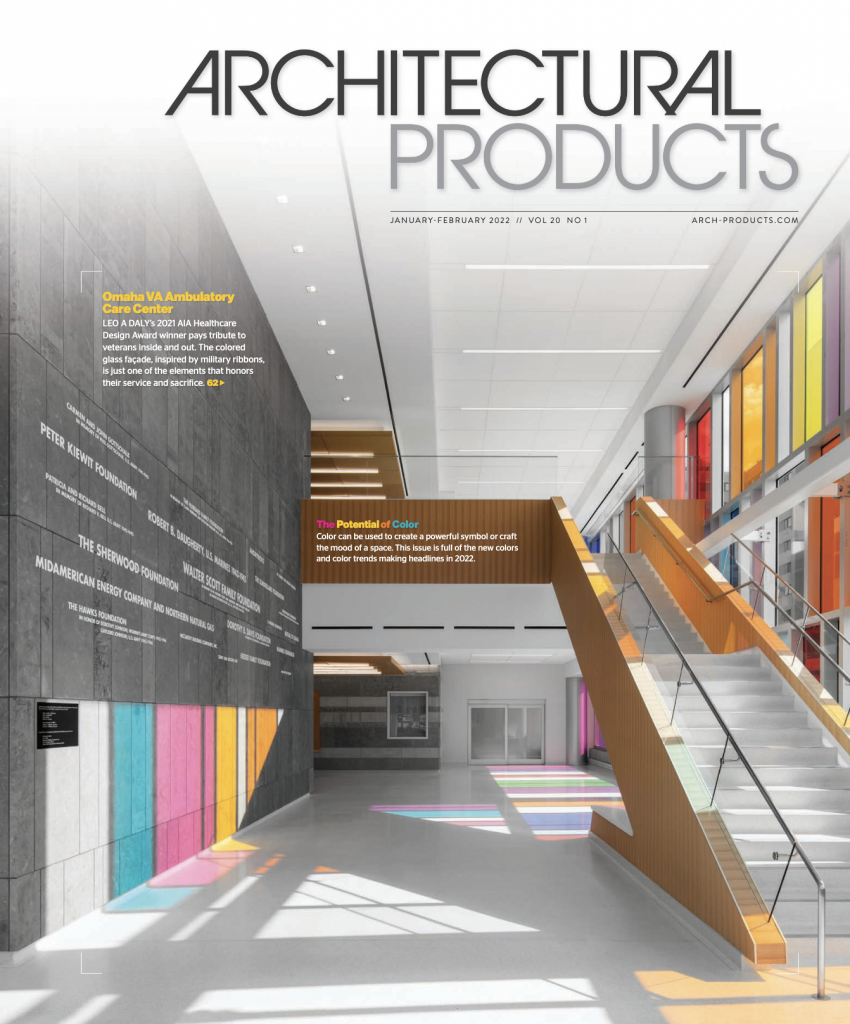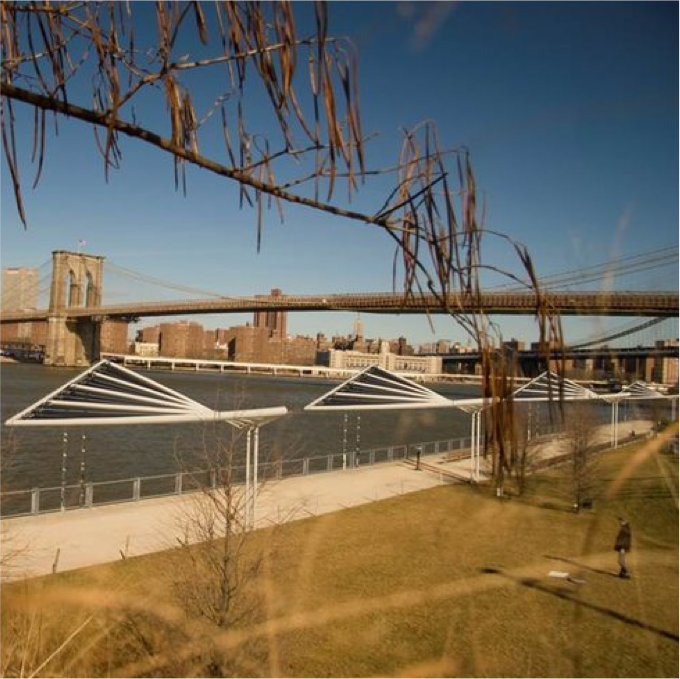
Category: hospitality


Textiles and alternative energy
June 10, 2024 | Textile Technology Source | By: Debra Cobb
From solar and wind, to carbon capture, textiles contribute to cleaner power.
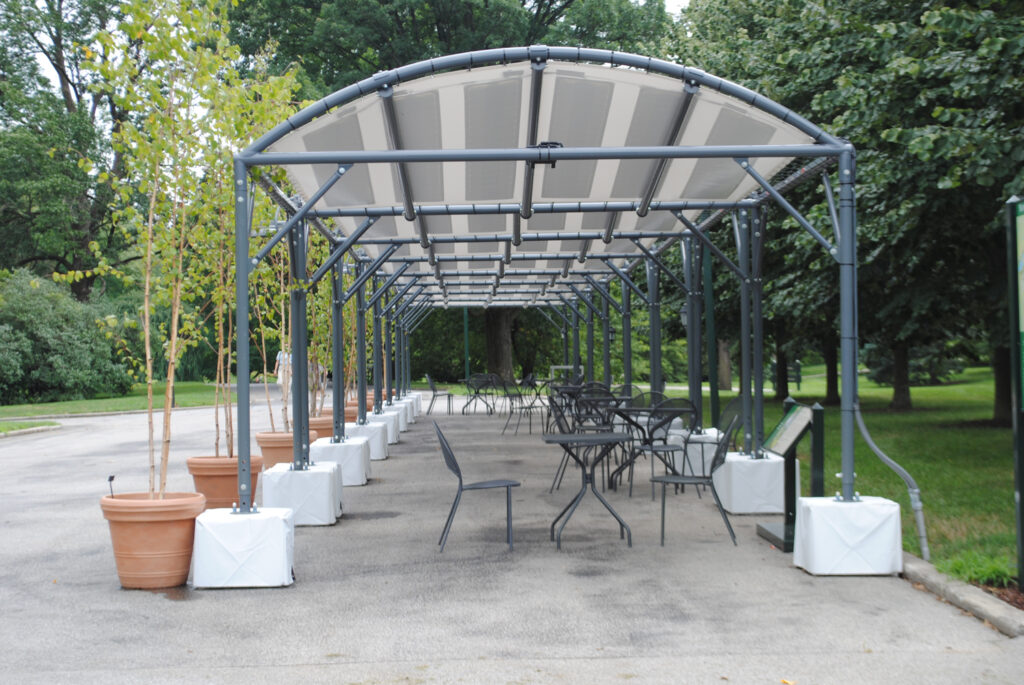
According to the International Energy Agency (IEA), the amount of renewable capacity added to energy systems around the world grew by 50 percent in 2023, reaching almost 510 gigawatts (GW), with solar PV accounting for three-quarters of additions worldwide.
The IEA forecasts that U.S. solar power generation will grow 75 percent from 163 billion kilowatt hours (kWh) in 2023 to 286 billion kWh in 2025. They also expect that wind power generation will grow 11 percent from 430 billion kWh in 2023 to 476 billion kWh in 2025. Hydrogen power and sustainable aviation fuel (SAF) are also poised for growth.
The economic opportunities provided by the generation of alternative energy, requiring new facilities, new materials and a wide range of feedstocks, could likewise fuel the growth of innovative and technical textiles. Seen and unseen, these critical components include unique polymers, composites, membranes and filters, as well as performance textiles for wind and solar that are lighter, stronger and often recyclable.
From solar cells to solar fabric
Recent developments in light weight, super-thin, flexible photovoltaics have enabled the solarization of fabrics, expanding the potential range of energy-producing form factors. Brooklyn-grown Pvilion laminates their solar cells to a variety of textiles to create a range of canopies, tents, curtains, building façades backpacks and clothing. “Once you have the panel, you can turn it into anything,” says Colin Touhey, the company’s co-founder and CEO.
Pvilion’s advantage is in its systems that provide both shelter and power in one structure to partners such as Carnegie Hall, Bloomberg, Tishman Speyer, The City of New York, Yale University, the U.S. Air Force, the Florida Dept. of Transportation and The City of Miami.
“Solar fabrics are getting better and better,” Touhey says. He explains that the company is agnostic regarding substrates, focusing instead on durability and longevity. Pvilion creates solar fabrics from rip-stop nylon, PVC-coated polyester, PTFE-coated fiberglass, Dyneema, and perhaps stretch substrates. “We care about quality,” he continues, pointing out that it is critical for Pvilion’s projects for the U.S. military, which also requires fabrics to be made in the U.S.
“We are more and more trying to build a line of finished product, as mass production is the goal for price,” says Colin. “But we are happy to work with people who have small volume. Being a solar power company doesn’t mean anything if it doesn’t fit into the customer’s requirements.”
From sails to wind turbines
A Scottish start-up called ACT Blade is revolutionizing wind power with an innovative fabric and specialized modular manufacturing system for turbine blades.
The new blades are longer in length without increased weight, and comprise fewer materials and simpler, streamlined production methods. They feature a slender supporting structure made from a composite material that is completely covered by the technical textile.
The protective outer shell for the wind turbine blades was manufactured by Concordia Textiles Group, based in Belgium. The fabric is reparable and is composed of elements that can be easily separated for recycling at end of life.
According to Rik Gekiere, Concordia’s sales and product manager, “We developed a laminate that is the common denominator of more than twenty technical requirements, by combining the strength and elasticity of a fabric with a protective layer. Rain erosion resistance and durability over time were the most challenging to achieve. We prefer to wait to provide more details of the product until the actual market release of the blades.”
ENEL Green Power S.p.A., an Italian multinational renewable energy corporation, is partnering with ACT Blade to develop the project.
A wind technology called OceanWings®, developed by VPLP Design in France, is said to enable a 45 percent savings in fuel consumption and a subsequent reduction in CO2e for sailing vessels. The vertical windsails provide aerodynamic lift and feature automated positioning to maximize thrust.
OceanWings are made from eco-composites that include linen fiber and recycled thermoplastic resins. The outer bag is 1000 denier nylon, with a layer of urethane to protect against punctures and abrasion.
The sails were first trialed in 2019 on the Energy Observer, an experimental vessel designed to test alternative energy sources in maritime conditions. In 2022 the commercial wind-powered cargo ship, the Canopeé, launched with four OceanWings that reduce fuel consumption by up to 42 percent in good weather conditions.
Green hydrogen: fuel of the future?
The World Economic Forum defines green hydrogen (H2) as hydrogen produced through electrolysis, usingrenewable electricity from solar or wind to split water into two hydrogen atoms and one oxygen atom. Green hydrogen can be used to decarbonize transportation, including heavy trucks, aviation and shipping, as well as in the manufacturing of steel, cement and other hard-to-abate industries.
At the heart of the green hydrogen process are proton exchange membranes, or PEMs. These membranes play a vital role in H2 production, fuel cells, and flow batteries for energy storage. The Chemours™Company, based in Wilmington, Delaware, dominates this market with their Nafion™ brand portfolio of membranes, dispersions, and resins.
Nafion is a synthetic polymer with unique ionic properties, created by incorporating perfluorovinyl ether groups terminated with sulfonate groups onto a tetrafluoroethylene (PTFE) backbone. The resulting product is a thermoplastic that can be extruded or solution-cast into films for composite membranes.
In response to a request for information, Nafion portfolio’s product manager referred to a paper published by Chemours’ technical team: “Advancements in Thin, Reinforced Proton Exchange Membranes for Water Electrolysis” by Ryan Gebhardt, et al.
“Employing a thinner and mechanically supported membrane can enhance both the electrochemical performance and mechanical properties. With the demand for cheaper hydrogen, these new membrane designs are needed to achieve advanced performance metrics,” it says.
While the green hydrogen economy is still in its infancy, the U.S. Dept. of Energy (DOE) recently announced $750 million, funded by the 2022 Bipartisan Infrastructure Law, for 52 projects across 24 states to reduce the cost of clean hydrogen. According to the DOE, clean hydrogen is set to play a vital role in reducing emissions from the most energy-intensive and polluting sectors of the economy.
For example, Airbus is testing the use of hydrogen fuel cells to generate electricity to power aircraft that fly with almost zero emissions. Airbus’ ZEROe project hopes to bring the world’s first hydrogen-powered commercial aircraft to market by 2035. Flight testing of the fuel cell propulsion system on an Airbus 380 is scheduled for 2026.
Decarbonizing aviation with SAF
The airline industry uses about 20 billion gallons of jet fuel every year, and globally aviation accounts for 2 percent of all CO2e and 12 percent of CO2e from transportation, according to the DOE.
Sustainable aviation fuel (SAF) reduces emissions from air transportation, and when blended with conventional aviation fuel is a drop-in for today’s aircraft and infrastructure. Depending on the feedstock and blend, SAF can reduce aviation’s CO2e by up to 80 percent.
There are several pathways to making SAF, based on various feedstocks. These include sustainably sourced renewable waste such as cooking oil and animal fat; biomass, such as agricultural and forest wastes and solid municipal waste; and power-to-liquid SAF made from captured CO2.
“Sustainable Energy Generation from Textile Biowaste and Its Challenges,” a paper by Khandaker, et al., Dept. of Textile Engineering, Dhaka University of Engineering & Technology, Bangladesh, reports that waste from the textile industry could also be a significant source of biomass for fuel.
LanzaJet, a sustainable fuels technology company spun out of LanzaTech in 2020, produces ethanol alcohol-to-jet SAF from any source of low-carbon ethanol, including biomass, industrial waste, municipal solid waste (MSW), and CO2. The company’s recently opened Freedom Pines facility in Soperton, Georgia, supported by DOE’s Bioenergy Technology Office (BETO), will produce nine million gallons of SAF and one million gallons of renewable diesel in its first year of operations.
LanzaJet and Tadweer, (Abu Dhabi Waste Management Company) are cooperating in a feasibility study to initiate SAF production from municipal and commercial solid waste. The hope is that up to 350,000 metric tons of hard-to-recycle municipal and commercial solid waste can be transformed into 200,000 metric tons of ethanol per year.
Tadweer’s facility will transform solid waste streams into a synthesis gas consisting of CO, CO2 and H2, via a gasification unit licensed by sustainable technology solutions provider NextChem, part of MAIRE Group. The gas stream is then transformed by LanzaTech’s microbe-powered bioreactor into CarbonSmart™ ethanol, which LanzaJet can then convert to SAF.
Renewable energy is a growth industry, accounting for 90 percent of all new electricity installed each year, worldwide. While it’s early days, there are opportunities for the textile industry to be involved.
A battery in a balloon
A company called Energy Dome, based in Milan, has developed a thermodynamic method of long-duration energy storage in a “battery” that uses CO2 stored in a huge fabric dome, like a balloon, made of PVC-coated polyester.
Energy from a local grid or nearby solar farm compresses the CO2 into a liquid during the day. At night, the liquid CO2 expands back into gas, driving a turbine that produces electricity and sending it back to the grid.
Energy Dome already has its first US installation planned for 2026 in Columbia County, Wisconsin, with Alliant Energy, and it has recently opened an office in Boston with a “growing ambition to decarbonize the world with our CO2 Battery™ technology.”
Debra Cobb is a freelance writer based in North Carolina with special expertise in the textile industry. She is a frequent contributor to Textile Technology Source.
To view the original article, click here.
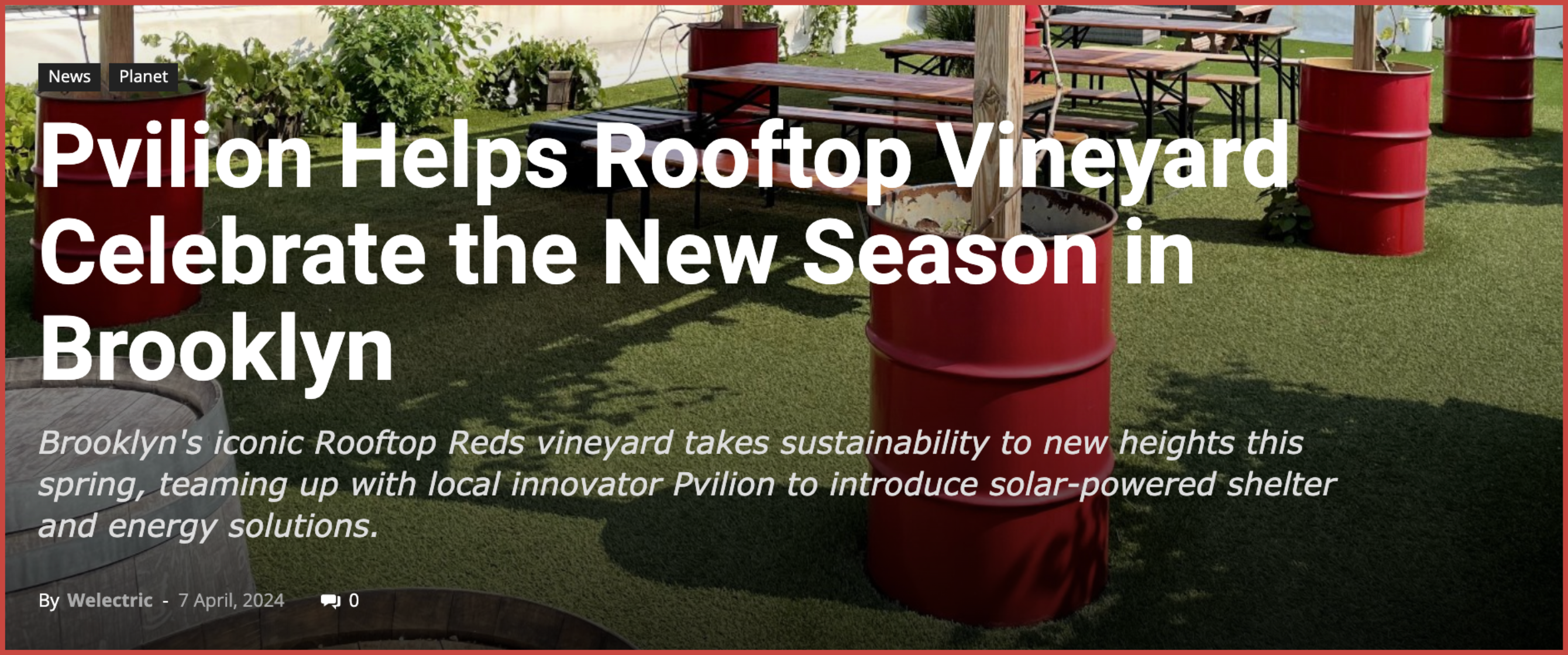
Pvilion Helps Rooftop Vineyard Celebrate the New Season in Brooklyn
April 7, 2024 | Welectric
Brooklyn’s iconic Rooftop Reds vineyard takes sustainability to new heights this spring, teaming up with local innovator Pvilion to introduce solar-powered shelter and energy solutions.
Pvilion, a small business specializing solar-powered fabric, is helping fellow Brooklyn-based business, Rooftop Reds, ring in the spring season with some solar-powered shade and power for visitors of the rooftop vineyard and wine bar.
Located in the Brooklyn Navy Yard, Rooftop Reds is the first of its kind and the only rooftop vineyard in New York City. With views of the Manhattan and Brooklyn skyline, it’s a popular spot for guests to enjoy a glass of wine with a view. That’s not all they offer, though. They have a full roster of events that visitors can attend – including movie nights, wine tastings, vineyard tours, locally sourced meals, and much more.

Rooftop Reds needed shelter for guests and power for events, and being an environmentally conscious and forward-thinking company, they reached out to Pvilion for an all-in-one solution. Pvilion designed, fabricated, and installed a solar powered fabric awning that matches the rooftop vineyard and wine bar’s aesthetic, provides enough power for events, and adds plenty of shade for guests to gather and partake in the festivities, come rain or shine.
After closing for the winter, this spring will mark the ninth season that the 15,000 square ft vineyard has been open for business and serving the community with its nearly 200 grapevines.
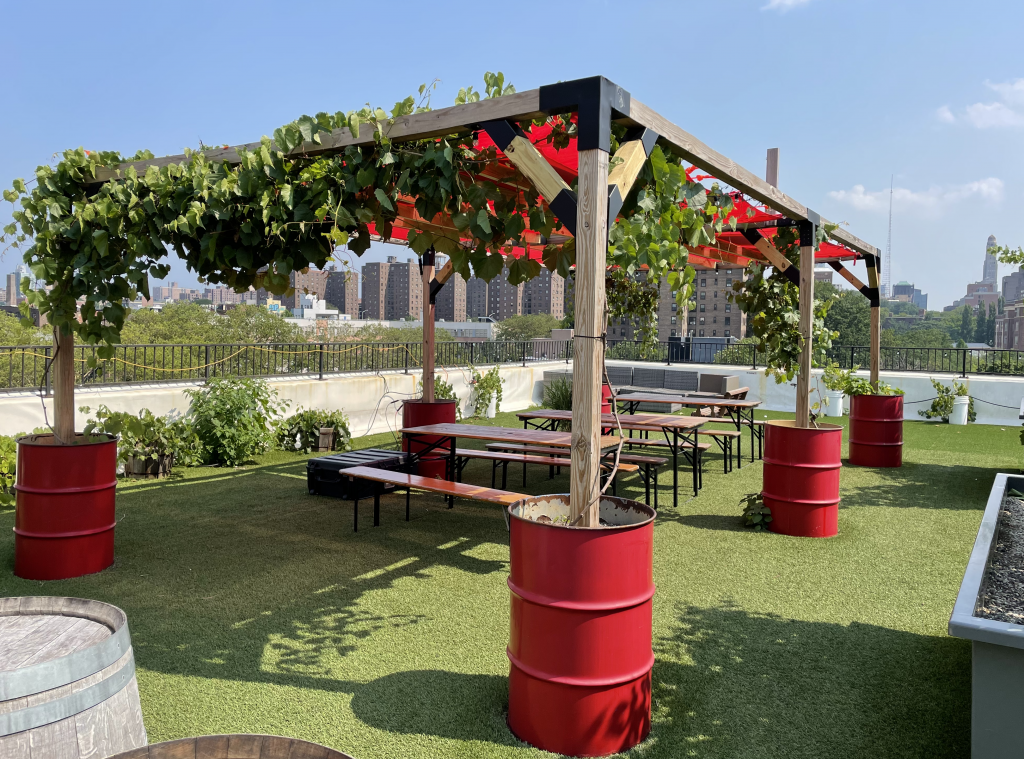
“Being a small business ourselves, we love getting the opportunity to support other small businesses, especially local ones! Rooftop Reds have been our neighbors for the past 10 years, until our recent move to Industry City. It’s been great to see all the incredible events they’ve been able to use our canopy to power and shelter since we installed it a couple of years ago,” said Pvilion CEO, Colin Touhey.
Pvilion is pioneering a new way of thinking about sustainability, power, and shade in the hospitality and event space. In addition to this, they have worked on projects like the Miami Bandshell concert venue, canopies at New York Botanical Garden, a rooftop event tent for Carnegie Hall, and most recently, portable solar fabric kits for the Coldplay: Music of the Spheres World Tour.
To view the original article, click here.
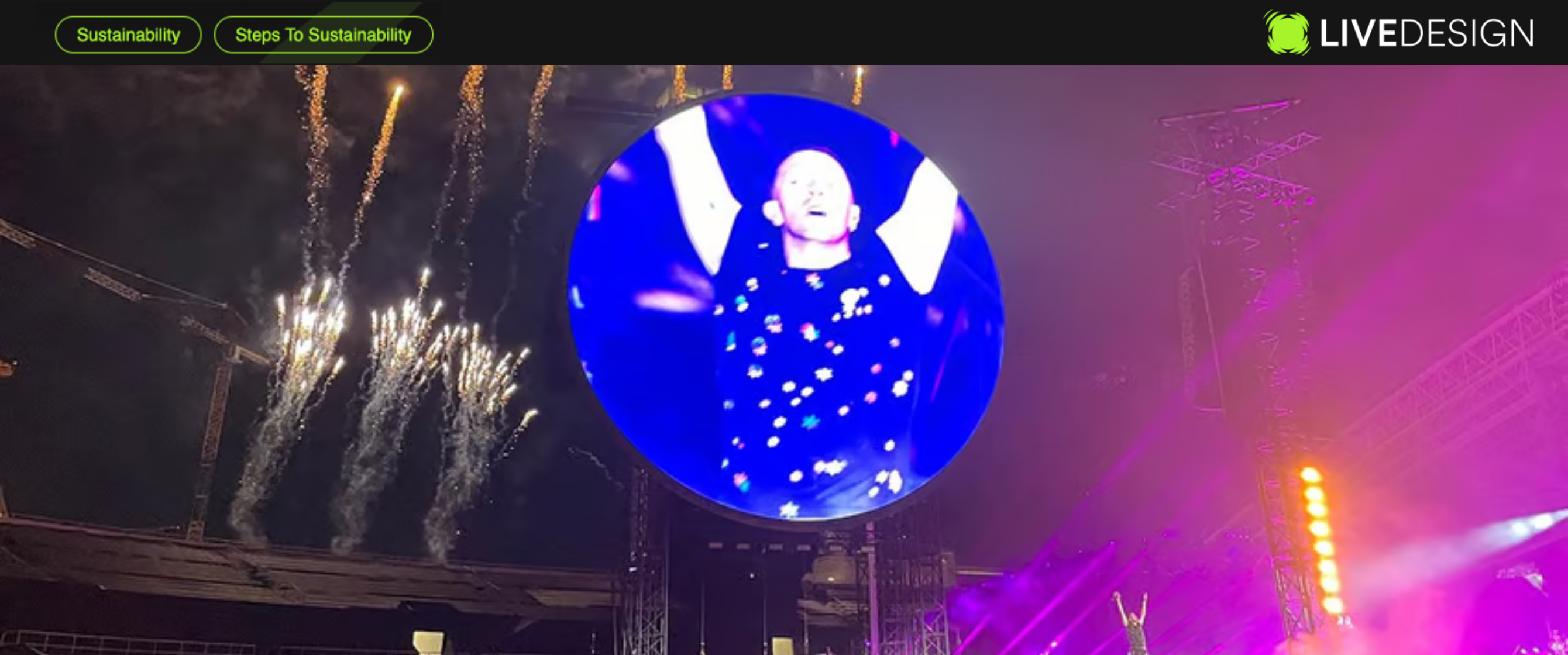
Steps To Sustainability: Pvilion Provides Portable, Renewable, Power
Mar 18, 2024 12:44pm | By Hannah Kinnersley
Very often in the search for sustainable solutions in the live entertainment industry we focus on fixing the issue after the fact, for example, by planting trees to offset carbon emissions, or recycling items we used to throw away, like wristbands used by audiences. But the biggest problems the industry has to address in order to make it less of a carbon offender are power generation and trucking. Currently, most tours and large, live events use massive diesel generators and only have access to renewable energy if the venue has invested in solar power or is purchasing renewable power from the grid, and even then it often will not cover the energy consumption for the event. Carrying solar panels with a tour would only increase the number of diesel trucks required, canceling out any benefit. However, one US company potentially has the answer to this dilemma, and it is already an established force in other fields with clients ranging from the US State Department to the military.

Pvilion, a Brooklyn-based solar fabric manufacturer creates rigid portable structures that are self-powered, the solar panels are built into the fabric and feed into batteries, making it ideal to set up tents for refugees or military encampments. And because the panels are small and set into the waterproof and windproof material, they are unlikely to crack, can be replaced more easily than traditional solar panels, and allows the fabric to be folded up for easy transport. The state department is using Pvilion systems that pop up into a portable solar array to generate power for disaster relief, and the Air Force relies on Pvilion’s solar-power for a project in a remote part of Alaska.
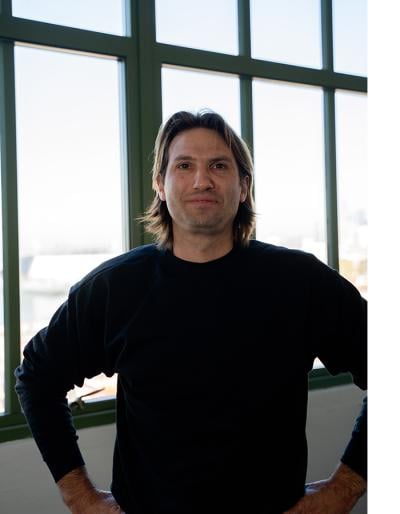
Electrical engineer Colin Touhey is a founder at Pvilion, which has been around for 12 years. His business partners in the venture are engineers that design and manufacture tents—not the type you might take hiking, but the kind you find covering airport terminals and amphitheatres. By introducing renewable energy into the equation, the applications for this type of structure have multiplied, and recently the entertainment industry has taken notice.
Live Design talked to Colin Touhey about his work in this area, uses in the entertainment industry, and the potential for the future.
Live Design: You are an electrical engineer, what brought you to the tent industry?
Colin Touhey: The engineers at FTL Design Engineering (now Buro Happold) had been designing tents basically since the 1970s, when it was almost an artisanal process, you would build a circus tent and hope it didn’t fall down. The company basically brought the industry into the 21st century by introducing modeling, structural analysis, and a high-tech building sciences perspective to it. In fact, it helped write the building codes because in the US there wasn’t really a rating, you couldn’t say that a tent could withstand a 65 mile an hour wind according to a building code. It really brought the industry into the forefront and now it’s just exploded and the amount of square footage of tentage or fabric structures around the world is tremendous. I joined as an electrical engineer in the mid 2000s to integrate energy generation into the tents.
My background is in electrical engineering and I started out working with solar and wind, but basically any kind of electricity generation project was fascinating to me. I came on board as a team member and we spun off this part of the business into Pvilion.

LD: What makes your use of this material unique?
CT: We design structures that are self-reliant, they generate the most erate energy from the fabric which feeds into a battery that provides lighting, air conditioning, and heating. We can do fully off the grid or emergency power depending on the size of the project.
Since we started, the fabric for the surface of the tents has become more and more powerful and the energy consumption inside the tents got lower [because of energy efficient lighting etc] and so they have reached an equilibrium. Most of the time we can produce 100% of the power for almost all applications.
LD: There are obviously huge applications in terms of housing for refugees and medical tents or military encampments, but how can it be used for live entertainment projects?
CT: There are several ways. Most recently, on the Coldplay Music of the Spheres tour, we use the fabric to cover the seats behind the stage in each stadium so that during the day it generates solar energy which feeds into a battery which in turn helps to power the show at night. It is a large piece of fabric, not seat covers in a traditional sense, and is draped over the area and then folded up and taken to the next venue. There is no reason why the fabric can’t be used be used by the venue whenever the stadium is empty but it makes more sense to use it to cover the roof of arenas and stadiums permanently. It is a much easier and more cost-effective version of traditional solar panels and can be used if there is some movement in the roof, for example a roof on a sports venue. A lot of the time there are cantilevered dome structures where you have an open center and 50 or 100 meters sticking out over the seats. The roofs are all fabric, and it could be lightweight solar fabric covering this massive area without building anything new or taking space from anything else.
So instead of running a diesel generator 24/7 for days during set up for a show, we’re basically flipping that on its head and saying let’s charge some batteries during the same period of time while the fabric is just sitting there and not creating pollution, and then discharge the battery during the concert.
On the Coldplay tour, the fabric generated about 100 kilowatt hours per day and we powered back of house and under the stage, which was around fifty people working under lights with laptops and all sorts of audio equipment and other gear. We can provide our own batteries but we didn’t for Coldplay because the tour had already partnered with BMW to provide recycled batteries.

LD: Could you get to a point where you only use a generator for two hours while the artist is on stage?
CT: You could, but the opposite would be better: not using the diesel during the concert and just running a smaller diesel generator slowly, in tandem with a renewable energy source to charge larger batteries. In theory, what you should be doing is coming to the venue with charged batteries and that way you don’t actually have to bring diesel generator trucks at all. There isn’t just one solution, there are different combinations for a solution.
Currently, there isn’t a battery out there that could power the demands of a large rock concert, but we are making baby steps toward a combination of battery and grid, and cutting down on diesel generators until we can do without them.
LD: How robust is the solar fabric? Would stadiums invest in it?
CT: When we do an architectural project it has a 25-year warranty, it is waterproof, rated for 450 mile-per-hour winds and significant weight of snow. It’s the permanent fabric that you see on projects like the Denver airport or London’s Millennium Dome [now known as The O2, designed to last 10 years and still going strong with tourists walking over the top of it and rock bands and events taking place inside it]. Our fabric is incredibly tough, Teflon-coated fiberglass, and yet you can fold it up around the solar cells like an accordion and move it around easily. A typical area of folding might be half a meter by two meters, so it would easily fit on a truck for a concert tour.
LD: Can you give a couple of examples where the fabric is in use in the US?
CT: In terms of permanent installations, in Tallahassee, Florida, we have a project called the Capital Cascades Connector Bridge. It’s a pedestrian bridge that we, designed, engineered, and installed the solar fabric for so that it generates its own lighting. The fabric also generates power for a mile-and-a-half long park there. Our products is also on the North Beach Bandshell Amphitheatre in Miami and it is used to power the lighting for that.
For temporary structures, we are renting out our systems to power summer events from clean energy sources. We’ve also built a tent on the roof of Carnegie Hall for a black-tie gala event. For small scale projects, the fabric is incredibly useful to get into non-traditional spaces and when you don’t want the noise and smell. We’re working with a traveling opera organization that should be touring this summer. For these outdoor events, rather than renting a generator, you rent a battery and a solar tent.
LD: Has there been more interest in this product since the Coldplay tour?
CT: There is more interest at the moment, and some of that is because there is legislation coming that will make it a bit harder to use generators. In California they are already banning small gas generators and a lot of emissive gas products.
LD: The obvious application to me would be festivals like Burning Man.
CT: Yes, music festivals and temporary events in cities wold benefit.
In addition to generating renewable energy, we are very, very good at structurally engineering things that use the fabric in efficient, lightweight and super strong structures that are very minimalist. Just a few poles or supports can create an incredibly strong surface. They are real rugged systems and reliable because you can’t have the lights go out for 15,000 people. Typically, at large-scale events, you have generators and back up generators, our system is very reliable, so that would be the primary power source, but the backup would be an emergency generator, not one running full time.
The other benefit is, a battery provides very consistent and high-quality power, a generator provides quite low-quality, inconsistent power, so a battery is very good for communications equipment, satellite dishes, medical applications, and things like that. If you need lighting for surgery, you don’t want a flicker.
LD: Are you actively targeting the entertainment industry? Who owns the fabric for the Coldplay tour?
CT: It is a different business model because tours typically rent everything, so Coldplay rented from PRG. Each production is custom, so getting into the supply chain is really challenging. The fabric is in the PRG inventory now, it is possible it might go out on the road again.
To read the original article, click here.
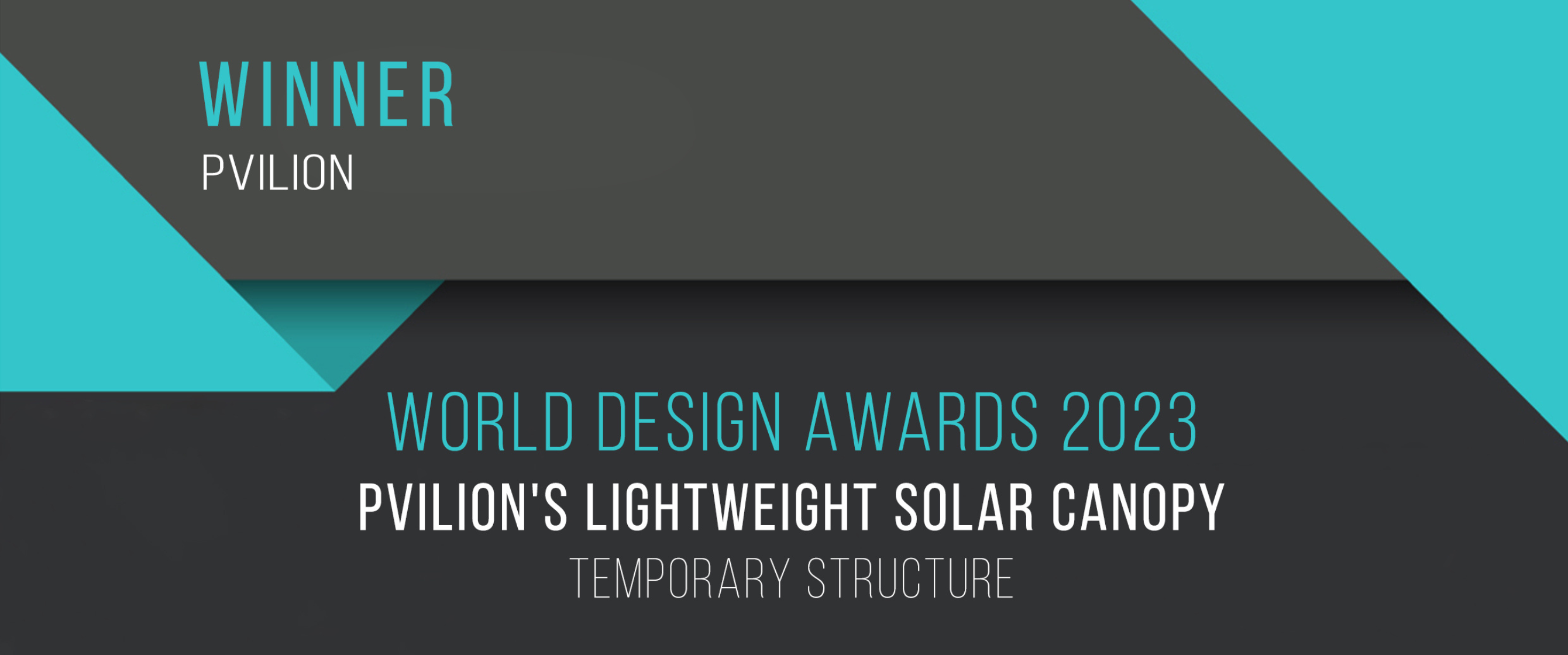
Pvilion’s Lightweight Solar Canopy | World Design Awards 2023
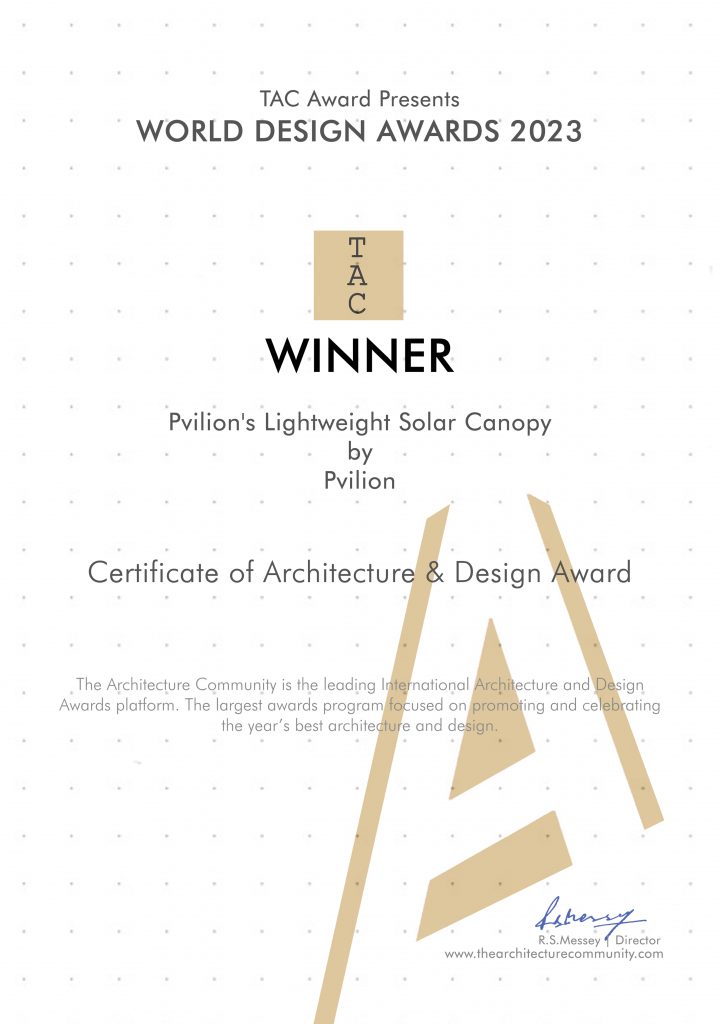
Firm: Pvilion
Designers: Todd Dalland, Robert Lerner, and Colin Touhey
Project Name: Pvilion’s Lightweight Solar Canopy
World Design Awards Category: Temporary Structure
Project Location: Brooklyn, New York
Country: United States
Photography Credit: Christopher Fenimore
To view the award, click here.
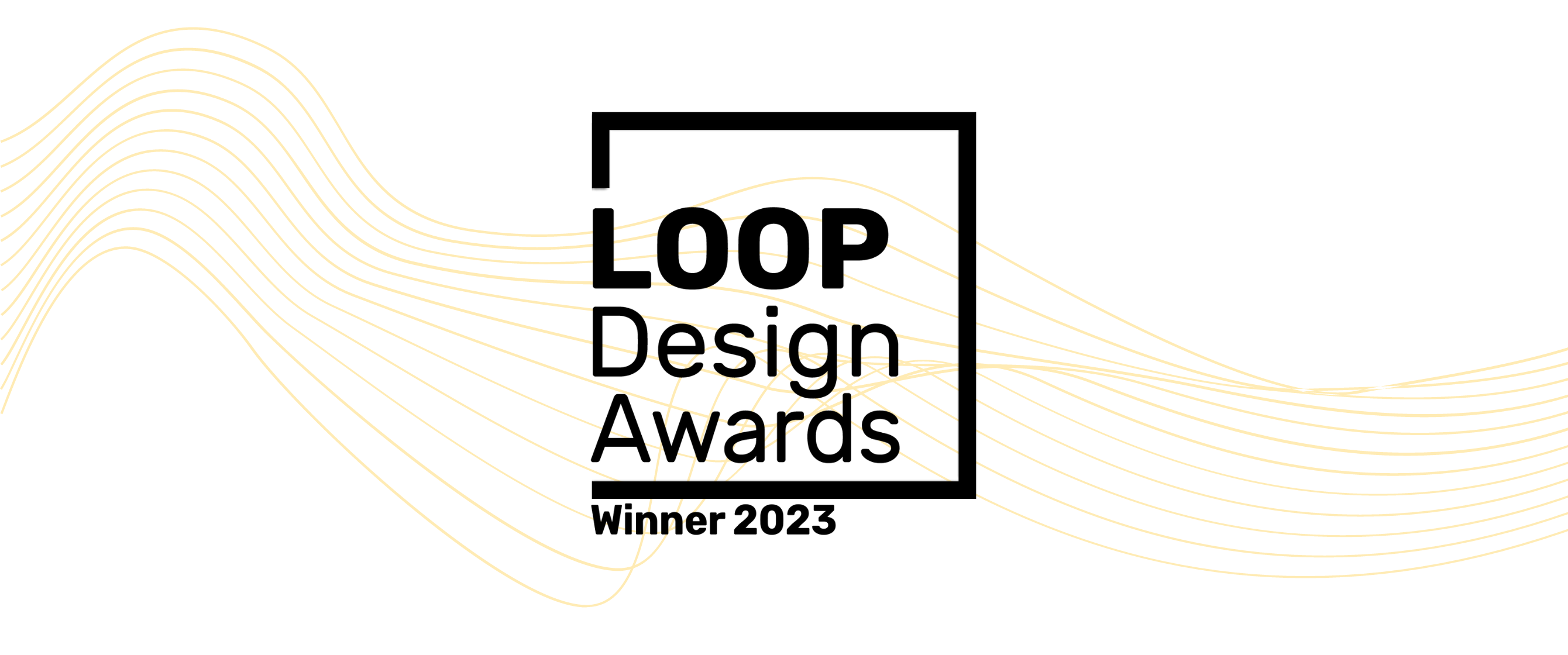
Outdoor Product Design Winner | 2023 LOOP Design Awards
Pvilion’s Portable Solar Sail wins a 2023 LOOP Design Award for Outdoor Product Design.
September 2023
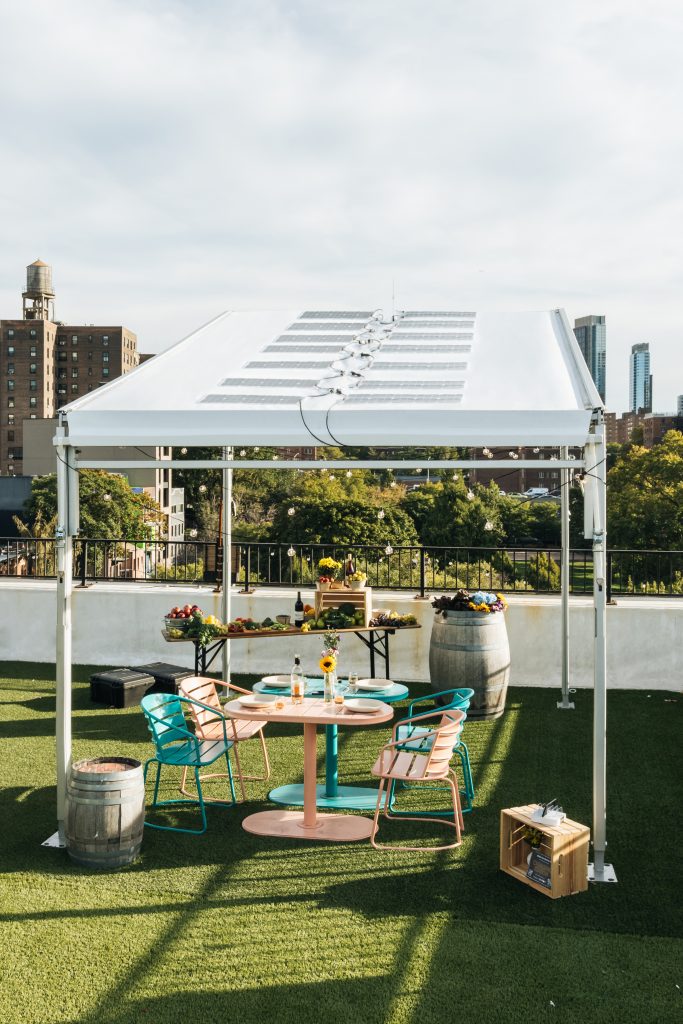
To view the award on the LOOP website, click here.

NYC Rooftop Vineyard Leverages Solar Power for F&B
The 15,000-square-foot Rooftop Reds space puts an emphasis on sustainability and social responsibility.
Hospitality Technology | June 29, 2022 | Robert Firpo-Cappiello
The founders of Rooftop Reds are on a mission.
The pioneering rooftop vineyard, spanning 15,000 square feet at NYC’s Brooklyn Navy Yard, boasts nearly 200 grapevines, colorful seating, decorative lights, and jaw-dropping views of the Manhattan and Brooklyn skylines. And its status as the first rooftop vineyard is just the beginning.
Promoting Sustainability
“We’re developing a new breed of urban agriculture and sustainability practices to help reduce the heat island effect and inspire creative thought regarding city green spaces,” says Rooftop Reds founder Devin Shomaker.
A major component of the vineyard’s sustainability practices is a partnership with fellow Brooklyn-based technology company Pvilion to install solar fabric installations onsite, allowing Rooftop Reds’ food and event programming — including pizza and wine movie nights; wine, chocolate, and oyster tastings; vineyard tours; and locally sourced dinners — to become primarily solar dependent for the height of the summer season.
“We host many food events at Rooftop Reds,” says Shomaker. “With the investment of solar systems, we are living our mission of being a sustainable and forward-thinking business.”
On a day-to-day basis, the solar installation mostly generates energy for the property’s perimeter and vineyard lighting. When Rooftop Reds hosts food events, they often use the stored solar energy to assist with their cookware energy needs.
“Solar is just another way we can promote and educate sustainability via our food programming,” says Shomaker. “While the economic benefits from solar for our business are quite minor, being able to speak about our values regarding sustainability practices with confidence is very important to both our staff and guests.”
Making Vineyards Accessible
Rooftop Reds’ mission also extends to social responsibility. By bringing the vineyard experience to the city, easily accessible via public transportation such as subway, bus, and ferry, the vineyard allows New Yorkers to enjoy an eco-friendly wine-culture experience close to home, without driving miles to the state’s renowned wine regions like the North Fork of Long Island or the Finger Lakes.
Shomaker and his partner TJ Provenzano and GM Irina Sargisova also hope to “de-snobify” wine culture by making it approachable, fun, and educational. “We accomplish this lofty goal by focusing on a 100% New York State wine, beer and cider list,” says Shomaker. “We offer a casual environment with beer garden & bistro tables, hammocks, yard games, porch swings, pergolas, and an outdoor movie theater on the rooftop. Wine can and should be fun to enjoy and share!”
Rooftop Reds produces a range of tasty, reasonably priced whites, sparkling wines, rosés, and, yes, reds, in collaboration with Point of the Bluff Vineyards, in Hammondsport, NY.
To read the full original article, click here.

Enjoying Super Shade
January – February 2022 // VOL 20 NO 1
CHALLENGE
Visitors to the New York Botanical Garden needed a place where they could seek shade, enjoy a beverage, and charge their mobile devices. To solve the garden’s need for accessible, sheltered outdoor seating, the NYC Department of Citywide Administrative Services (DCAS) and the Botanical Garden turned to Pvilion and their solar-powered shade canopies.
SOLUTION
Pvilion was recently recognized for sustainable efforts by The Architecture MasterPrize for outstanding outdoor, sustainable, and overall product design. One of the company’s products – the Quad Pole Solar Sail – was installed in the Botanical Garden. This solution combines a fabric integrated with photovoltaic cells and a powder-coated steel frame. When erected in an area that receives sunlight, the solar sail can offer energy independent from the local electrical power grid. The structures also come with the option to tie into the local grid, either as a consumer or producer of electricity.
According to the manufacturer, “Eight solar canopies were designed, engineered and installed by Pvilion at the New York Botanical Garden, providing ample space to relax while staying socially distanced. As part of New York City’s emission reduction efforts, seven of the canopies contribute energy directly to the city’s power grid. One structure powers a bank of batteries used by the Garden and its visitors to charge their mobile phones and other devices.”
With the recent need to shift activity outside, Pvilion’s technology has become a necessary, quick, and reliable energy-efficient solution for shelter and energy. The structures in the Botanical Garden were erected by a handful of workers and operational within a matter of hours.
“The climate crisis is real and it is urgent, and that is why the City of New York is taking action to reduce carbon emissions and build a more sustainable future,” said Lisette Camilo, Commissioner of the NYC Department of Citywide Administrative Services. It is only fitting that the New York Botanical Garden, a place known for its greenery, will be leading the way with green energy technologies.
NEEDS MET
Pvilion’s solar power canopy structures meet both short and long-term needs while avoiding the costs, environmental damage, and time associated with erecting and running permanent structures.
To view the full digital edition, click here.
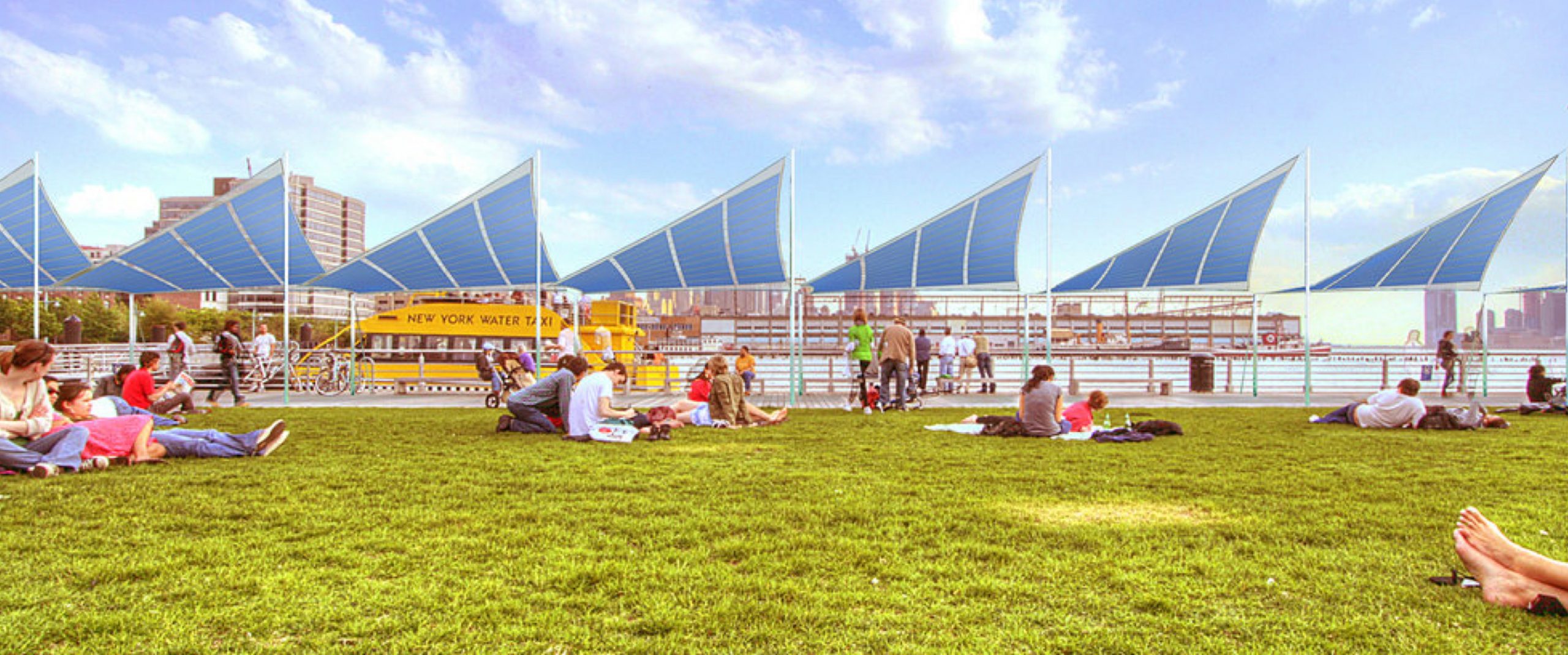
Waterfront Solar Canopy Modules
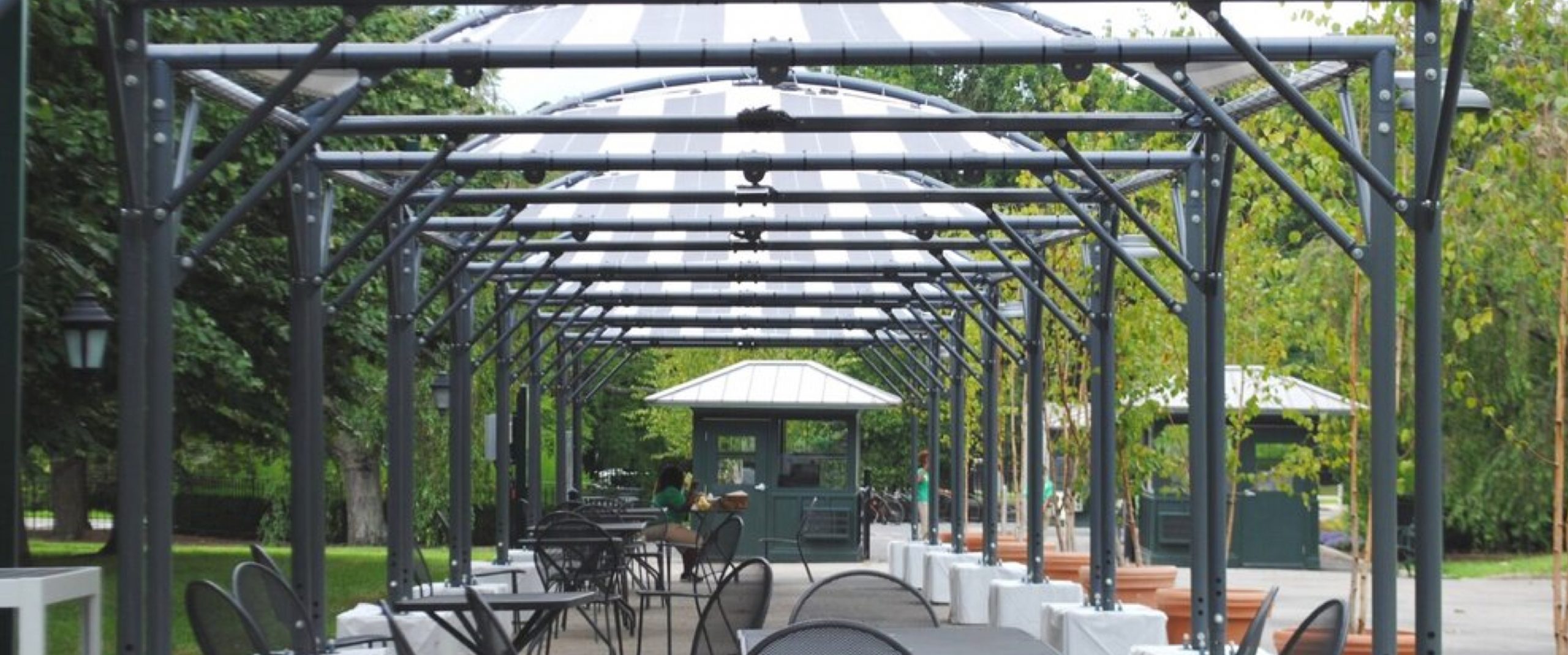
Pvilion Solar Canopies at The New York Botanical Garden
Aesthetic appeal is important in a botanic garden, which is why the NYC Department of Citywide Administrative Services (DCAS) chose The New York Botanical Garden (NYBG) as the launch site for Pvilion’s Solar Powered Canopy structures. Pvilion, a Brooklyn based solar-powered fabric products company, has installed solar canopies which are not only functional and environmentally friendly, but pleasant to look at when one is standing on the grounds of the Botanical Garden.
“As the city’s botanical gardens reopen and welcome back visitors to enjoy the peace and tranquility of their living collections, we’re thrilled to support this collaboration between the New York Botanical Garden, Pvilion, and DCAS,” said Gonzalo Casals, NYC Cultural Affairs Commissioner.
Intended to provide NYBG visitors a place where they can seek shade, enjoy a beverage and recharge their mobile devices, the eight (8) solar canopies, designed, engineered, and installed by Pvilion, provide ample space to relax while staying socially distanced.
Pvilion engineered a fabric that incorporates photovoltaic cells, which generate electricity with sun exposure. As part of New York City’s emission reduction efforts, seven (7) of the canopies contribute energy directly to the city’s power grid. One (1) structure powers a bank of batteries used by NYBG and by Garden visitors to charge their mobile phones, and other devices.
The solar canopies are a pilot project operated by Pvilion under the Innovative Demonstrations for Energy Adaptability (IDEA) Program, an initiative of the City of New York’s DCAS’ Division of Energy Management. The program encourages businesses, innovators, and entrepreneurs to create transformative opportunities and to foster a culture of innovation.
NYC Cultural Affairs Commissioner Casals added that “DCAS’s IDEA program that funded the installation of these innovative, solar powered pavilions on NYBG’s extraordinary grounds is just one way the City partners with cultural organizations to lead the way in fostering sustainable design – something that’s more urgently needed than ever.”
The goal is to find solutions to the challenges facing manufacturers and businesses through partnerships with private sector business entities, with emphasis placed on technology to help the City reduce carbon emissions.
“The climate crisis is real and it’s urgent, and that is why the City of New York is taking action to reduce carbon emissions and build a more sustainable future,” said Lisette Camilo, Commissioner of the NYC Department of Citywide Administrative Services. “It’s only fitting that The New York Botanical Garden, a place known for its greenery, will be leading the way with green energy technologies.”
Pvilion’s design stands out for its flexible durability, minimal weight, energy efficiency and ease of installation. With the recent need to shift activity outside, Pvilion’s technology has become a necessary, quick, and reliable solution for shelter and energy. The NYBG structures were erected by a handful of workers and operational within a minimal amount of time. Pvilion’s products are not only visually pleasing, but they are helping the world we live in today to achieve a better tomorrow.
